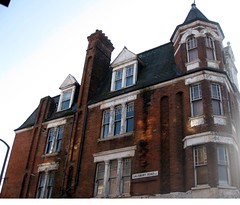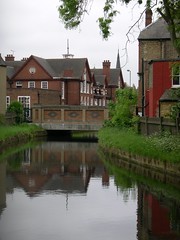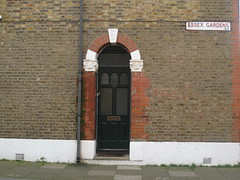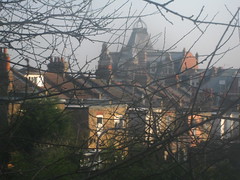English Heritage are currently running a campaign to protect the 9,300 conservation areas in England.
Despite the fact we have our own rich neighbourhood heritage in the form of Grand Parade, the late Victorian and early Edwardian architecture of the Ladder and Gardens and the oldest park in London as well as the traditions surrounding the Harringay Stadium and Arena, inexplicably we are not a conservation area.

However, by the sounds of it, being a conservation area does not necessarily protect an area from neglect, damage and damaging change.
English Heritage revealed the Top 10 threats to our neighbourhood heritage today:
– plastic windows and doors (83% of conservation areas affected)
– poorly maintained roads and pavements (60%)
– street clutter (45%)
– loss of front garden walls, fences and hedges (43%)
– unsightly satellite dishes (38%)
– the effects of traffic calming or traffic management (36%)
– alterations to the fronts, roofs and chimneys of buildings (34%)
– unsympathetic extensions (31%)
– impact of advertisements (23%)
– neglected green spaces (18%).
All but the last one sound horribly familiar, don't they?
What seems depressing to me is that areas where local councils actually have the powers to protect are struggling, so what chances do areas that have not been designated have?
Still, two of the three recommendations seem to make sense for those that are responsible for guiding Harringay's future, namely the Green Lanes Strategy Group and the Neighbourhood management team
Firstly, all departments need to be responsible for conserving a neighbourhood. Some joined up thinking from the council on how Highways, Environmental, Housing, even Health and Education can work together. After all, people's mental and physical health is improved when the area they live in is pleasant, clean and cared for.
Secondly, they believe that local people are the best people to help get the processes going with residents groups helping councils by finding out what local people value, by doing street clutter audits, commenting on planning applications or helping to prepare local lists of historic buildings. Where there is strong community support, projects are much more successful.
The chief executive of EH, Simon Thurley expresses it thus:
Well-cared for [neighbourhoods] ... encourage good neighbourliness, give a boost to the local economy and will continue to be a source of national pride and joy for generations to come.”



Haringey conservation areas 'at risk'
Despite the fact we have our own rich neighbourhood heritage in the form of Grand Parade, the late Victorian and early Edwardian architecture of the Ladder and Gardens and the oldest park in London as well as the traditions surrounding the Harringay Stadium and Arena, inexplicably we are not a conservation area.

However, by the sounds of it, being a conservation area does not necessarily protect an area from neglect, damage and damaging change.
English Heritage revealed the Top 10 threats to our neighbourhood heritage today:
– plastic windows and doors (83% of conservation areas affected)
– poorly maintained roads and pavements (60%)
– street clutter (45%)
– loss of front garden walls, fences and hedges (43%)
– unsightly satellite dishes (38%)
– the effects of traffic calming or traffic management (36%)
– alterations to the fronts, roofs and chimneys of buildings (34%)
– unsympathetic extensions (31%)
– impact of advertisements (23%)
– neglected green spaces (18%).
All but the last one sound horribly familiar, don't they?
What seems depressing to me is that areas where local councils actually have the powers to protect are struggling, so what chances do areas that have not been designated have?
Still, two of the three recommendations seem to make sense for those that are responsible for guiding Harringay's future, namely the Green Lanes Strategy Group and the Neighbourhood management team
Firstly, all departments need to be responsible for conserving a neighbourhood. Some joined up thinking from the council on how Highways, Environmental, Housing, even Health and Education can work together. After all, people's mental and physical health is improved when the area they live in is pleasant, clean and cared for.
Secondly, they believe that local people are the best people to help get the processes going with residents groups helping councils by finding out what local people value, by doing street clutter audits, commenting on planning applications or helping to prepare local lists of historic buildings. Where there is strong community support, projects are much more successful.
The chief executive of EH, Simon Thurley expresses it thus:
Well-cared for [neighbourhoods] ... encourage good neighbourliness, give a boost to the local economy and will continue to be a source of national pride and joy for generations to come.”



Haringey conservation areas 'at risk'
Tags for Forum Posts: heritage, preservation
Replies to This Discussion
-
BTW, Noel Park also used to have it's own railway station! Noel Park & Wood Green. Unfortunately, it was closed down by the 'forward thinking' conservative Minister of Transport .. Dr Beeching in 1963 .. (No I won't get on to politics) but I just thought it needed an airing with the other Noel Park stuff..
-
I agree, fascinating, lots of history... The smaller cotages were apparently built for and lived in by the railway workers when Wood Green tube station was being built. The white coller workers lived in the fancier ones, the end houses for example have turrets, whilst some in the middle of a terrace have gables.
Going off the subject slightly... I am watching breaking news that Michael Jackson has just died. Is it going to be a 'what were you doing' when MJ died?
I will never forget posting this one, that's for sure!
-
Yes- Noel Park is not only a conservation area, it is an Article 4 conservation area, the highest level of protection afforded conservation areas. However, the council does not enforce it. I agree with those who say this is an East/West issue. This would not happen on the other side of the tracks.
We have started a conservation area advisory committee in Noel Park and are trying to change that. We are currently putting together a leaflet to raise awareness.
-
I am really pleased to hear that, great idea! I would be more than happy to stock some of your leaflets and give them to prospective purchasers. We can all raise awareness very early on perhaps.
-
Sorry, I've just picked up this discussion from the weekly e mail bulletin. I've got a history of Noel Park by Caroline Welch; maybe it's well known, in which case my apologies. The Leigham Court Estate in Streatham was designed by the same architect as Noel Park and looks very similar. Lambeth have published this guidance for complying with its article 4 direction and conservation status.http://www.lambeth.gov.uk/NR/rdonlyres/54156052-DF1A-431D-8590-4BED.... You won't be surprised to learn that the supplementary planning guidelines aren't enforced - they have one planning officer trying to cover far too much within the council. The estate is mostly council owned, though 50% + is now leasehold. They were subject to a stock transfer proposal to a housing association a couple of years ago. This was voted down. As far as I know, the council isn't any more able to maintain the integrity of the buildings, so it's looking a bit sorry for itself ( in addition to all the hideous planning violations).
-
Just thought you may find these stats interesting, although they are eight years old now!
http://www.haringey.gov.uk/noel_park.pdf
-
I too strongly suspect that a well-cared for environment and attractive well designed buildings - old and new - have a knock-on effect on the value of property. For this reason, I also think that the 'carrot' of enlightened self-interest could well be an even more effective motive for conservation than the 'stick' of enforcement.
(Perhaps Steve Hatch would offer a free professional view on this?)
If I'm right, then one question becomes: how do we persuade property owners to think medium and longer term? So they consider that paying to retain and maintain original features is a sensible investment decision with a real bottom-line payoff?
On the East/West divide, I can't argue with Liz. Though I'd point out that the two main enormous new developments in Tottenham are not Haringey's, but both by private companies. The largest is the new stadium and associated development by Tottenham Hotspurs. (The club already owns or has "assembled" much of the land.)
The next largest development is on a site immediately east of Tottenham Hale Station. This was once the publicly-owned GLS supplies depot. This land - being turned into an idyllic modern village by Lee Valley Estates Ltd, was originally sold-off (to Middlesex University) for what is now peanuts.
-
I think EH have already enlisted the estate agents on this. If it all sounds a bit po faced to talk about 'preserving local heritage' perhaps a simple economic perspective will help people see the value of this.
From the EH website:
"There are also financial reasons why caring for your conservation area makes sense. An English Heritage poll of estate agents reveals that 82% think original features add value to a property and 75% think being in a well-kept conservation area enhances house prices."
But Alan, doesn't your photo just illustrate the point? If they were trying to put such an ugly development in the middle of Muswell Hill, there would be uproar!
As it is, people in the east are supposed to be glad that someone is even bothering. Who will live in Hale Village? What is to stop these being bought up by buy-to-let landlords who neglect them and the environoment as has happened in other modern developments? How is a neighbourhood mentality fostered by such architecture? Is the development what people in the area wanted? etc.
I'm not saying new housing is not needed. It is. However, there should also be much more emphasis on refreshing and caring for existing neighbourhoods and not allowing them to go to rack and ruin.
btw have you read 'A Journey through ruins' by Patrick Wright (you probably have) which is an analysis of the changing face of London post WW2 until Thatcher's 80s through the prism of Dalston. His chapters on high rise housing should be required reading for every Haringey council officer in the housing dept.
-
A conservation area doesn't in my mind have to be all old buildings.. On Grand Parade, the 1950s building comes to mind.. perfectly mirroring the development of the area, but not pristine Grand Parade and worthy of being conserved.
I have to say, I really like old buildings, put to new use.. but first and foremost, a stop has to/must be made to the creeping DIY modernisations ...
Then at a later stage, ideas about fitting in newer developments could be made...
Liz, I'm writing this clutching my copy of A journey...' in my left hand.. do I pass the test?
-
Only if you've read 'On living in an old country' as well :)
-
boo hoo..... I knew I was a failure...
-
For those of you who think I'm a Know-It-All negative type of person..
I'm going to prove you all right now by adding this link to a blog whose writer thinks on similar lines to me..
Now if only I were positive and wrote all the nice cosy things you want to hear..
- ‹ Previous
- 1
- 2
- 3
- 4
- Next ›
© 2025 Created by Hugh.
Powered by
![]()